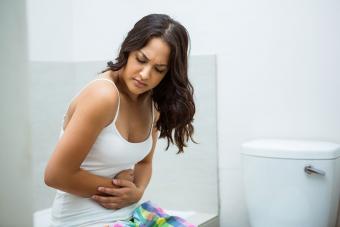
If you're pregnant, you may become worried if you begin to experience cramping. In your first trimester, you may wonder if the cramping is from your uterus stretching and growing. Later in your pregnancy, you may worry if cramping is a sign of early labor or simply Braxton Hicks contractions.
Your body goes through a lot of changes throughout pregnancy, and while some of these changes are expected, other changes - such as cramping - may have you wondering if everything is okay. Even though cramping can sometimes indicate a problem, cramps and abdominal twinges are usually normal and not a sign that something is wrong.
Why Pregnancy Cramping Occurs
Cramping can mean different things during pregnancy, depending on how far along you are. Consider these different causes of cramping at various stages of pregnancy.
First Trimester Cramping
Cramping early in your pregnancy can occur as the fetus implants into the uterine lining and settles in for the next several months. Spotting is also normal during this time. This is called implantation spotting and implantation cramping, which typically occurs around the time you would expect to get your period.
During the first trimester, it is normal to experience mild cramping off and on in your lower abdomen as your body changes right along with your developing baby. As your baby grows, your uterus grows along with it. You may feel pulling, tugging, or stretching that feels similar to menstrual cramps as your uterus stretches and grows.
In some cases, cramping in the first trimester may be a sign of miscarriage or ectopic pregnancy. If cramping is accompanied by spotting or bleeding, contact your healthcare provider.
Second Trimester Cramping
Abdominal cramps and twinges are common during the second trimester. Round ligament pain is a common pregnancy symptom in the second trimester, which occurs as the uterus and surrounding ligaments stretch to accommodate your growing baby. Round ligament pain often feels like sudden sharp or jabbing pain on one or both sides of the lower belly and groin area. Round ligament pain is often felt after quick movements, such as coughing or quickly standing up from sitting.
To reduce round ligament pain, consider:
- A birthing/exercise ball for sitting
- A heating pad (electric or sticky Thermacare pads placed directly on the skin)
- A maternity belt
- A pillow placed between your legs while sleeping
- A warm bath/shower
- Pregnancy yoga
- Taking your time when standing from bed or a chair
In some cases, pregnancy cramping during the second trimester may be a sign of a urinary tract infection (UTI). UTIs are most common between weeks 6 to 24 of pregnancy, and up to 8% of pregnant people will experience a UTI during their pregnancy. Contact your healthcare provider if you think you may have a UTI.
Third Trimester Cramping
Mild cramping is common during the third trimester, as the body prepares for labor. Braxton Hicks contractions, also known as false labor, occur as the uterus prepares for labor and delivery. These contractions are usually painless, though they may be uncomfortable for some pregnant people and lead them to believe that they are going into labor.
Around weeks 34 and 35 of pregnancy, your body is preparing for labor and delivery. Menstrual-like cramps are common during this time and are usually not a cause for concern. However, if your cramping is accompanied by other labor symptoms such as backache, pressure, or spotting, your labor may be starting. If you are less than 37 weeks pregnant, contact your healthcare provider. They may ask you to rest and drink plenty of fluids or come in for an appointment to be examined if the cramping persists.
After week 37 (full-term), pregnancy cramping may be a sign that labor is beginning. At the start of labor, many people report that contractions feel like menstrual cramps. If you are in early labor and the pain is not too intense yet, you may want to consider comfort measures, such as:
- A slow walk or swimming
- Distracting yourself with chores, chatting with your partner or friends, watching a movie, or reading a book
- Getting a massage from your partner, family member, or doula
- Taking a bath or shower
- Using a heating pad on your back
- Sitting and bouncing on a birthing ball
If you are in early labor, don't forget to eat unless your care provider has told you not to. Aim to eat nutritious foods to help keep your energy levels up, such as fresh fruits, whole-grain toast or a sandwich, energy bars, smoothies, or dried fruit and nuts. Be sure to drink plenty of fluid during this time to stay hydrated.
When Should I Contact My Doctor?
Though some cramping is normal during each trimester of pregnancy, it is important to contact your healthcare provider if you have:
- More than six contractions in an hour
- Dizziness, lightheadedness
- Vaginal bleeding
- Intense back pain
- Nausea, vomiting, and/or fever
- Cramps that are persistent and not improving over time
Your healthcare provider will be able to gather information and make personalized recommendations for your health and the health of the baby.







